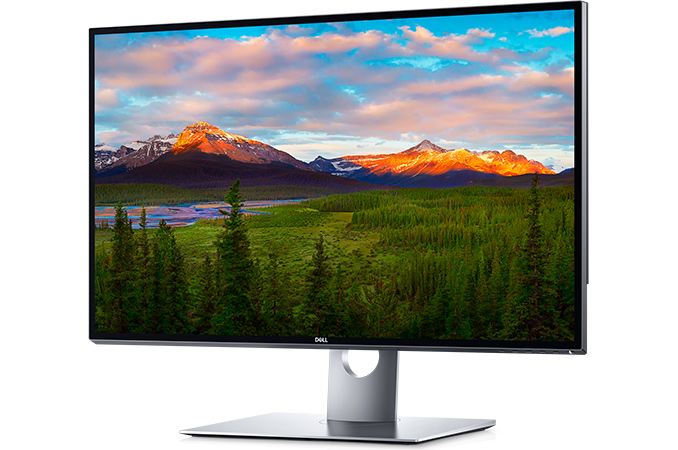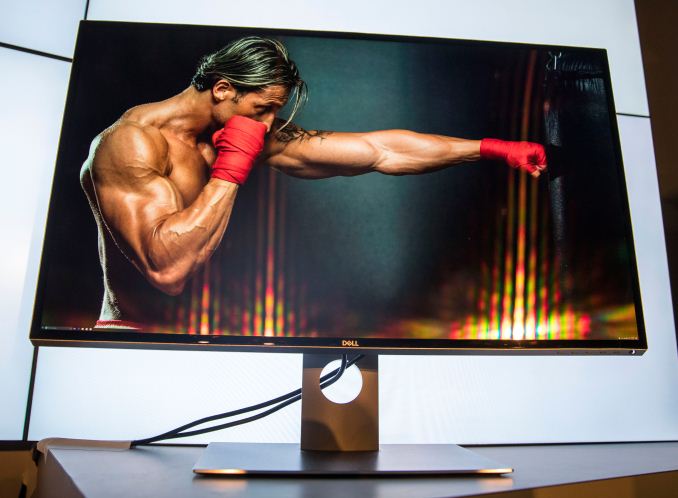Dell Announces UP3218K: Its First 8K Display, Due in March
by Anton Shilov on January 10, 2017 1:00 PM EST- Posted in
- Monitors
- Displays
- Dell
- Trade Shows
- UHD
- Ultrasharp
- 8K
- CES 2017
- UP3218K

Dell introduced the industry’s first mass-market 8K display aimed at professional designers, engineers, photographers and software developers. The UP3218K will be available this March, but its rough $5,000 price tag will be rather high even for professionals dealing with content creation. That being said, $5K or so was the price that the original 4K MST monitors launched at in 2013, which perhaps makes this display price more palatable. On the other hand, right now an 8K professional display is such a niche product that the vast majority of users will have to wait a few years to see the price come down.
Up to now, 8K reference displays were available only from Canon, in very low quantities and at very high prices. The displays were primarily aimed at video professionals from TV broadcasting companies like NHK, who are working on 8K (they call it Super Hi-Vision) content to be available over-the-air in select regions of Japan next year. A number of TV makers have also announced their ultra large 8K UHDTVs, but these are hardly found in retail. Overall, Dell is the first company to offer an 8K display that can be bought online by any individual with the money and be focused on the monitor market rather than TVs.
At present, Dell is not publishing the full specifications of its UltraSharp 32 Ultra HD 8K monitor (UP3218K), but reveals key specs like resolution (7680×4320), contrast ratio (1300:1), brightness (400 nits), pixel density (280 ppi) as well as supported color spaces: 100% Adobe RGB and 100% sRGB.
| Preliminary Specifications Dell UltraSharp 32 Ultra HD 8K (UP3218K) |
||
| Panel | 32" (IPS?) | |
| Resolution | 7680 × 4320 | |
| Brightness | 400 cd/m² | |
| Contrast Ratio | 1300:1 | |
| Refresh Rate | 60 Hz | |
| Viewing Angles | 178°/178° horizontal/vertical | |
| Color Saturation | 100% Adobe RGB 100% sRGB |
|
| Display Colors | 1.07 billion | |
| Inputs | 2 × DisplayPort 1.3 | |
For interconnection with host PCs, as a single DisplayPort 1.3/1.4 cable does not provide enough bandwidth for the 7680×4320@60 Hz configuration Dell is targeting, the UltraSharp UP3218K uses two DisplayPort 1.3 inputs to provide the necessary bandwidth, stitching the two display streams together internally using tiling. This is similar to early 5K displays, which used a pair of DisplayPort cables to get around the bandwidth limitations of DisplayPort 1.2. Using two cables not a big problem given the target market, but it's interesting to note that because 7680×4320@60Hz alone consumes all of the bandwidth supplied by the two cables, there isn't any leftover bandwidth to support HDR or the Rec. 2020 color space.
On a side note, while the company could have used DisplayPort 1.4's Display Stream Compression 1.2 (DSC) feature to reduce the bandwidth requirements of the monitor, they opted not to. DSC is promoted as visually lossless, but given how demanding many professionals are and problems that potential artifacts introduced by DSC could bring, Dell decided to stick to two DisplayPort cables as a result.
While a high display resolution is good for photos and images, it also makes everything smaller; and while modern operating systems support scaling, it does not work perfectly for all programs. It's likely that professional applications like AutoCAD or Photoshop will support 8K the day the UltraSharp UP3218K hits the market, but general use applications, already struggling with 4K and HiDPI in general, will be another matter. Practically speaking, if the price tag alone isn't convincing enough that this is a monitor for specific editing tasks and not for general desktop usage, then the lack of good HiDPI support elsewhere will. And while I'm sure someone will try to use the UP3218K as a gaming display, at four times the resolution of a 4K monitor, we're at least a few years off from GPUs being able to render high-fidelity games at a 33Mpix resolution.
Dell promised to start sales of the Dell UltraSharp 32 Ultra HD 8K monitor (UP3218K) on March 23 on its web-site. Initially, the monitor is stated to cost $4999. Time to put in some hardware requisition forms.
Related Reading:
- ASUS ProArt PA32U Display: 4K, 1000 Nits Brightness, 95% DCI-P3, 85% Rec. 2020
- LG Announces 32UD99: 4K IPS Display with 95% DCI-P3, HDR and USB-C
- BenQ Launches the SW320: a 4K Display with HDR for Professionals
- Panasonic Develops IPS Panel with 1,000,000:1 Contrast Ratio, 1000 Nits Brightness
- EIZO Launches ColorEdge CG2730 and CS2730 2560×1440 Displays for Professionals and Prosumers
- Dell Introduces UltraSharp UP3017 30-Inch Professional Display with 16:10 Aspect Ratio and DCI-P3 Color Space
Source: Dell













40 Comments
View All Comments
Ahnilated - Tuesday, January 10, 2017 - link
You might want to fix this: Dell decided to stick to two DP 1.4 cables as a result.It should actually read: Dell decided to stick to two DP 1.3 cables as a result.
osteopathic1 - Tuesday, January 10, 2017 - link
The display has 4 x the resolution of a 4K monitor, shouldn't this be a 16K Monitor?DVDxR - Tuesday, January 10, 2017 - link
Like 4K the name is based (loosely) on the horizontal resolution, so 8K.lilmoe - Tuesday, January 10, 2017 - link
Like DVRxR said; 4k doesn't mean "four times the resolution of FHD". It means that it has 4 thousand (k = kilo = thousand) horizontal dots/pixels. It's a common misunderstanding.2K, 4k and 8k are DCI cinema formats. The respective consumer screen formats are FHD, UHD, and UUHD (?? dunno what it'll be called). DCI and consumer formats share the same amount of vertical pixels; 1080p, 2160p and 4320p respectively.
2K = 2048x1080
4K = 4096x2160
8K = 8196x4320
fanofanand - Friday, January 13, 2017 - link
I believe the latest marketing jargon is SUHDr3loaded - Tuesday, January 10, 2017 - link
A monitor like this would be the perfect application for HDMI 2.1, which has the bandwidth to carry 8K@60Hz with HDR losslessly over a single cable. Just need to wait for controllers and cables carrying the spec to appear, followed by being integrated into monitors and graphics cards now.r3loaded - Tuesday, January 10, 2017 - link
Actually, better yet HDMI 2.1 can carry 8K@120Hz or even 10K@120Hz.DanNeely - Tuesday, January 10, 2017 - link
HDMI 2.1 is still a year or two from shipping products, and it can only do 8k 120 at 4:2:0 color depth - which is sorta acceptable for TV use, but has pixel level artifacts that make it unsuitable for use as a monitor. 10k while not defined (my unscientific wag would be 5x*2 or 10240x5760, although an ultra wide format wouldn't surprise me either), is going to have the same or worse bandwidth limits at 120hz which means it'd also be color compressed and cancer if used as a monitor.stanleyipkiss - Tuesday, January 10, 2017 - link
Why no mention that no video card outside the new Pascal Quadros have the required DP 1.4 outputs?edzieba - Tuesday, January 10, 2017 - link
The 10xx series also have the required DisplayPort version.